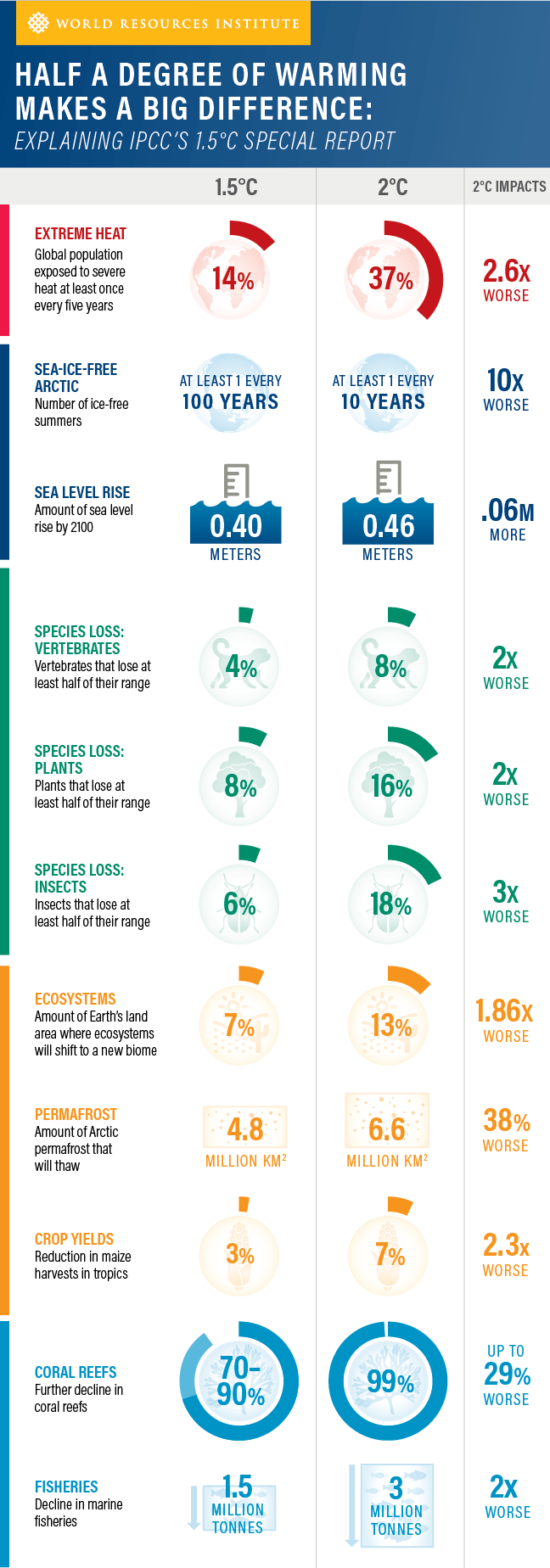
- The press release
- Frequently Asked Questions
- The Summary For Policy Makers (SPM)
- The full report
What is Driving this Report?
Once the Paris Agreement was on track for establishment in 2015, the UNFCCC started the process for the production of this report.
It has a very tight constraint, those producing it can only lean upon studies published within credible scientific journals so this is a summary of the very best scientific evidence available.
Hoesung Lee, Chair of the IPCC explaines that …
“With more than 6,000 scientific references cited and the dedicated contribution of thousands of expert and government reviewers worldwide, this important report testifies to the breadth and policyrelevance of the IPCC,”
Ninety-one authors and review editors from 40 countries prepared the IPCC report in response to an invitation from the United Nations Framework Convention on Climate Change (UNFCCC) when it adopted the Paris Agreement in 2015.
Scope and Impacts
There is a great deal to digest. In essence the report is telling us this …
- Humans are wholly and completely responsible for about 1C of warming (the range is roughly 08. to 1.2), and between 2030 and 2052 that number will reach 1.5C of warming.
- This change will persist for thousands of years. As time progresses, this will profoundly alter the climate system – for example sea level rise will keep rising
- If we can reach and then sustain net zero CO2 emissions we can halt the ongoing rise, but in the longer term, we need negative CO2 emissions to prevent further warming due to feedback systems
The risks we face at 1.5C are higher than the risks we face today, and the risks we face at 2C are even higher than the risks we face at just 1.5C. Translation – even doing our very best and limiting it all to 1.5C will still expose us to increased risks. Here is a quick summary via WRI that contrasts 1.5 with 2C …
The above illustrates what happens to sea level by 2100 (just 80 years from now). There is nothing magic about 2100, sea level will simply carry on rising in all the centuries beyond that date, and that remains true even if we limit warming to 1.5C. You might wonder why bother with just 1.5C. It matters because a slower the rate gives us a greater window of opportunity to adapt.
What Happens now?
What of course is truly shocking is that we are on track to not limit global warming to 1.5C or even 2C, and so it is highly probable that we as a species will simply not be rational enough to collectively take a sufficient degree of action to avoid disaster.
It is tragic because right now it is possible, and yet we can’t avoid the observation that we also live in a world of Trump inspired lunacy that declares facts to be myth, and embraces myths as fact.
PolicyMaker summary – Extracts
The following is a very brief extract from the summary, from here. (It runs to 33 pages)
A. Understanding Global Warming of 1.5°
A1. Human activities are estimated to have caused approximately 1.0°C of global warming above pre-industrial levels, with a likely range of 0.8°C to 1.2°C. Global warming is likely to reach 1.5°C between 2030 and 2052 if it continues to increase at the current rate.
A.2. Warming from anthropogenic emissions from the pre-industrial period to the present will persist for centuries to millennia and will continue to cause further long-term changes in the climate system, such as sea level rise, with associated impacts (high confidence), but these emissions alone are unlikely to cause global warming of 1.5°C (medium confidence)
A3. Climate-related risks for natural and human systems are higher for global warming of 1.5°C than at present, but lower than at 2°C (high confidence). These risks depend on the magnitude and rate of warming, geographic location, levels of development and vulnerability, and on the choices and implementation of adaptation and mitigation options (high confidence)
B. Projected Climate Change, Potential Impacts and Associated Risks
B1. Climate models project robust differences in regional climate characteristics between present-day and global warming of 1.5°C, and between 1.5°C and 2°C. These differences include increases in: mean temperature in most land and ocean regions (high confidence), hot extremes in most inhabited regions (high confidence), heavy precipitation in several regions (medium confidence), and the probability of drought and precipitation deficits in some regions (medium confidence).
B2. By 2100, global mean sea level rise is projected to be around 0.1 metre lower with global warming of 1.5°C compared to 2°C (medium confidence). Sea level will continue to rise well beyond 2100 (high confidence), and the magnitude and rate of this rise depends on future emission pathways. A slower rate of sea level rise enables greater opportunities for adaptation in the human and ecological systems of small islands, low-lying coastal areas and deltas (medium confidence).
B3. On land, impacts on biodiversity and ecosystems, including species loss and extinction, are projected to be lower at 1.5°C of global warming compared to 2°C. Limiting global warming to 1.5°C compared to 2°C is projected to lower the impacts on terrestrial, freshwater, and coastal ecosystems and to retain more of their services to humans (high confidence).
B4. Limiting global warming to 1.5°C compared to 2C is projected to reduce increases in ocean temperature as well as associated increases in ocean acidity and decreases in ocean oxygen levels (high confidence). Consequently, limiting global warming to 1.5°C is projected to reduce risks to marine biodiversity, fisheries, and ecosystems, and their functions and services to humans, as illustrated by recent changes to Arctic sea ice and warm water coral reef ecosystems (high confidence).
B5. Climate-related risks to health, livelihoods, food security, water supply, human security, and economic growth are projected to increase with global warming of 1.5°C and increase further with 2°C.
B6. Most adaptation needs will be lower for global warming of 1.5°C compared to 2°C (high confidence) There are a wide range of adaptation options that can reduce the risks of climate change. There are limits to adaptation and adaptive capacity for some human and natural systems at global warming of 1.5°C, with associated losses (medium confidence). The number and availability of adaptation options vary by sector (medium confidence).
C. Emission Pathways and System Transitions Consistent with 1.5°C Global Warming
C1. In model pathways with no or limited overshoot of 1.5°C, global net anthropogenic CO2 emissions decline by about 45% from 2010 levels by 2030 (40–60% interquartile range), reaching net zero around 2050 (2045–2055 interquartile range). For limiting global warming to below 2°C CO2 emissions are projected to decline by about 20% by 2030 in most pathways (10–30% interquartile range) and reach net zero around 2075 (2065–2080 interquartile range). Non-CO2 emissions in pathways that limit global warming to 1.5°C show deep reductions that are similar to those in pathways limiting warming to 2°C. (high confidence)
C2. Pathways limiting global warming to 1.5°C with no or limited overshoot would require rapid and far-reaching transitions in energy, land, urban and infrastructure (including transport and buildings), and industrial systems (high confidence). These systems transitions are unprecedented in terms of scale, but not necessarily in terms of speed, and imply deep emissions reductions in all sectors, a wide portfolio of mitigation options and a significant upscaling of investments in those options (medium confidence).
C3. All pathways that limit global warming to 1.5°C with limited or no overshoot project the use of carbon dioxide removal (CDR) on the order of 100–1000 GtCO2 over the 21st century. CDR would be used to compensate for residual emissions and, in most cases, achieve net negative emissions to return global warming to 1.5°C following a peak (high confidence). CDR deployment of several hundreds of GtCO2 is subject to multiple feasibility and sustainability constraints (high confidence). Significant near-term emissions reductions and measures to lower energy and land demand can limit CDR deployment to a few hundred Gt CO2 without reliance on bioenergy with carbon capture and storage (BECCS) (high confidence).
D. Strengthening the Global Response in the Context of Sustainable Development and Efforts to Eradicate Poverty
D1. Estimates of the global emissions outcome of current nationally stated mitigation ambitions as submitted under the Paris Agreement would lead to global greenhouse gas emissions in 2030 of 52–58 Gt CO2eq yr-1 (medium confidence). Pathways reflecting these ambitions would not limit global warming to 1.5°C, even if supplemented by very challenging increases in the scale and ambition of emissions reductions after 2030 (high confidence). Avoiding overshoot and reliance on future large-scale deployment of carbon dioxide removal (CDR) can only be achieved if global CO2 emissions start to decline well before 2030 (high confidence).
D2. The avoided climate change impacts on sustainable development, eradication of poverty and reducing inequalities would be greater if global warming were limited to 1.5°C rather than 2°C, if mitigation and adaptation synergies are maximized while trade-offs are minimized (high confidence).
D3. Adaptation options specific to national contexts, if carefully selected together with enabling conditions, will have benefits for sustainable development and poverty reduction with global warming of 1.5°C, although trade-offs are possible (high confidence).
D4. Mitigation options consistent with 1.5°C pathways are associated with multiple synergies and trade-offs across the Sustainable Development Goals (SDGs). While the total number of possible synergies exceeds the number of trade-offs, their net effect will depend on the pace and magnitude of changes, the composition of the mitigation portfolio and the management of the transition. (high confidence)
D5. Limiting the risks from global warming of 1.5°C in the context of sustainable development and poverty eradication implies system transitions that can be enabled by an increase of adaptation and mitigation investments, policy instruments, the acceleration of technological innovation and behaviour changes (high confidence).
D6. Sustainable development supports, and often enables, the fundamental societal and systems transitions and transformations that help limit global warming to 1.5°C. Such changes facilitate the pursuit of climate-resilient development pathways that achieve ambitious mitigation and adaptation in conjunction with poverty eradication and efforts to reduce inequalities (high confidence).
D7. Strengthening the capacities for climate action of national and sub-national authorities, civil society, the private sector, indigenous peoples and local communities can support the implementation of ambitious actions implied by limiting global warming to 1.5°C (high confidence). International cooperation can provide an enabling environment for this to be achieved in all countries and for all people, in the context of sustainable development. International cooperation is a critical enabler for developing countries and vulnerable regions (high confidence).
Tweets
https://twitter.com/IPCC_CH/status/1049113146361860097
Some thoughts on the @IPCC_CH #SR15 report.
"The best time to start [reducing emissions] was 25 years ago. The second best time is today."https://t.co/yHmtsjJAJD
— Gavin Schmidt (@ClimateOfGavin) October 8, 2018
1. These are today's emissions and top emitters. We included this graphic for a reason. #SR15 https://t.co/mW1QjLpm7H pic.twitter.com/761JnJ2uA9
— Chris Mooney (@chriscmooney) October 8, 2018
Scientists are holding a press conference on their new dire #SR15 climate report live-streamed here: https://t.co/xLq14VmXct
— Carl Zimmer (@carlzimmer) October 8, 2018
We must reduce greenhouse gas emissions to net zero or face more floods | Nicholas Stern https://t.co/QgThUJRTH2 #IPCC #SR15 #globalwarming #climatechange
— The Guardian (@guardian) October 8, 2018
The new IPCC report shows how we can stop global warming. That includes cutting short-lived climate pollutants like the methane leaking from oil and gas operations.
Phil McKenna has the details on #SLCPs discussed in #SR15 https://t.co/hb26wEr0r8
— InsideClimate News (@insideclimate) October 8, 2018
World leaders told they must act over climate change 'cliff-edge' https://t.co/3c6mZ5igeb #IPCC #SR15 #globalwarming #climatechange
— The Guardian (@guardian) October 8, 2018
This however is the true root of all concern …
Highly significant tweet. @IPCC_CH says emissions have to go down by over a billion tons per year and that has to start immediately. Yet here's @IEA saying emissions from the biggest source — energy — haven't even peaked yet. They're still rising. https://t.co/6LAoUBEFjo
— Chris Mooney (@chriscmooney) October 8, 2018

